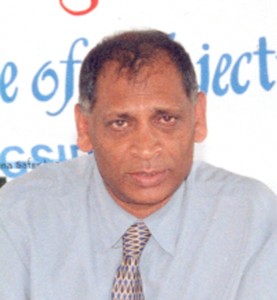The Ministry of Health is to commence house-to-house visits coupled with distribution of medication in another exercise aimed at eliminating Lymphatic Filariasis (LF) by the year 2012.

This initiative comes on the heels of the DEC-salt campaign which has been ongoing since 2003.
LF is a parasitic disease caused by microscopic, thread-like worms. The adult worms only live in the human lymph system.
The exercise which is slated to start in Region Five will be duplicated in all ten regions and will be the beginning of the ministry’s campaign to see LF eliminated by 2012, although Guyana has signed onto a global obligation to eliminate the disease by 2020.
At a press conference on Friday Minister of Health Dr Leslie Ramsammy said that the ministry has reduced the time frame by eight years because it is confident the elimination can be accomplished in a shorter period.
Reduction
This has been made possible because of the significant decrease in LF cases over the last few years which the ministry believes can be attributed to the DEC-salt campaign.
Ramsammy said at the press conference that management data has shown between 24.6% to 61.8% reduction in cases of LF and an almost 88% reduction in hydrocele (a collection of watery fluid around the testicle) since the DEC-salt campaign.
Therefore this new programme is referred to as a “mopping up exercise to ensure Guyana reaches the elimination stage,” Ramsammy said. The programme is being done in conjunction with the ministry’s vector control unit which will conduct their exercises simultaneously.
Although the programme is directly aimed at LF it will also target other forms of worm infestation. According to the minister some 50,000 people are expected to be reached in Region Five. The area is divided into four geographical areas, referred to as clusters, and volunteers will visit each cluster on scheduled days.
Ramsammy said that everyone will be offered treatment except for children under two and lactating women. The mass treatment will include having vulnerable family members, including children, take one Albendazole and DEC tablets.
The volunteers will distribute de-worming medication and assist persons with diseases associated with LP such as lymphoedcema (the swelling of an extremity, resulting from poor drainage of fluid through the lymphatic system – swelling of the feet usually called “bigfoot”) and hydrocele. Persons will be referred to special clinics at the Georgetown or New Amsterdam Hospitals.
Since last Wednesday volunteers have been in the villages taking blood and stool samples to determine the base line prevalence for LF and other worms. This will be repeated in six months to determine any new prevalence and to measure the impact of the exercise.
Volunteers
Almost 200 volunteers from the Health, Education, Local Government, and Amerindian Ministries have been screened and trained to help with this programme. Volunteers are also drawn from the Volunteer Youth Corps, Youth Challenge Guyana, CIOG, UNICEF and a number of other organisations.
Minister Ramsammy urged persons to cooperate fully with the volunteers as the programme is rolled out to all the regions.
More than 120 million persons live with LF globally, with some 40 million suffering from incapacitating conditions. Some 20,000 Guyanese are estimated to be living with this condition. Communities usually shun persons disfigured by the disease and these persons are usually unable to work and take care of their families because of their disabilities.




